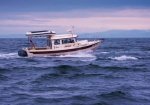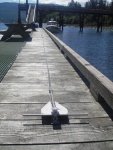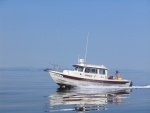sebastien
New member
- Joined
- Aug 7, 2018
- Messages
- 70
- Reaction score
- 0
- C Dory Year
- 2000
- C Dory Model
- 22 Cruiser
- Hull Identification Number
- 2674387994
- Vessel Name
- kittiwake
I really appreciate all the feedback I’ve been getting from everyone.
I’ve been trying to reply to each new post but I am loosing track a little bit..
I am spending a couple of weeks on Swans Island in Maine and this is my nightly home work once my hosts retire.
Yes I am familiar with the technique of over drilling, under-cutting and epoxying screw holes with balsa cored construction and
will use the same process fo the actual large hole of the deck pipe.
I’ve been reading the posts about replacing those stupidly installed lazaret covers on the later model boats (mine has the built in kind thankfully)
What I did not know is the nitty gritty of the materials to do this with and
so far I have learned to use west system 105 with 206 or 209 hardeners deeding on season.
I have learned to thicken it with medium density filler for the larger holes like for my deck pipe so it stays in place.
and I have derived the idea that whenever possible it is best to just use a nut and bolt rather than a “wood” screw into the epoxy to prevent cracks etc.
It seems “Dr. bob” from Thataway doesn’t like to seat things with 3M 5200 and likes Boatlife “Lifeseal” better (Both urethanes though).
Maybe Dr. Bob ought to put a "Complete guide to C-dory maintenance and upgrades" book - I would buy it for sure!
SO MUCH TO LEARN! but the C-Brats website makes it feel like a joyful community shared experience rather than feel like a lonely web-research rabbit hole obsession.
Thanks for all the feedback everyone! I look forward to getting back to Philly and Pompano (soon to be renamed Kittiwake) and start work.
I’ve been trying to reply to each new post but I am loosing track a little bit..
I am spending a couple of weeks on Swans Island in Maine and this is my nightly home work once my hosts retire.
Yes I am familiar with the technique of over drilling, under-cutting and epoxying screw holes with balsa cored construction and
will use the same process fo the actual large hole of the deck pipe.
I’ve been reading the posts about replacing those stupidly installed lazaret covers on the later model boats (mine has the built in kind thankfully)
What I did not know is the nitty gritty of the materials to do this with and
so far I have learned to use west system 105 with 206 or 209 hardeners deeding on season.
I have learned to thicken it with medium density filler for the larger holes like for my deck pipe so it stays in place.
and I have derived the idea that whenever possible it is best to just use a nut and bolt rather than a “wood” screw into the epoxy to prevent cracks etc.
It seems “Dr. bob” from Thataway doesn’t like to seat things with 3M 5200 and likes Boatlife “Lifeseal” better (Both urethanes though).
Maybe Dr. Bob ought to put a "Complete guide to C-dory maintenance and upgrades" book - I would buy it for sure!
SO MUCH TO LEARN! but the C-Brats website makes it feel like a joyful community shared experience rather than feel like a lonely web-research rabbit hole obsession.
Thanks for all the feedback everyone! I look forward to getting back to Philly and Pompano (soon to be renamed Kittiwake) and start work.



